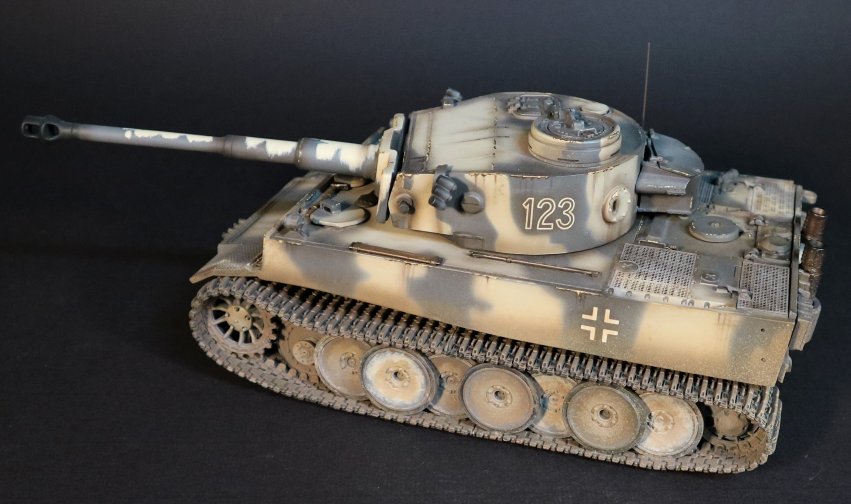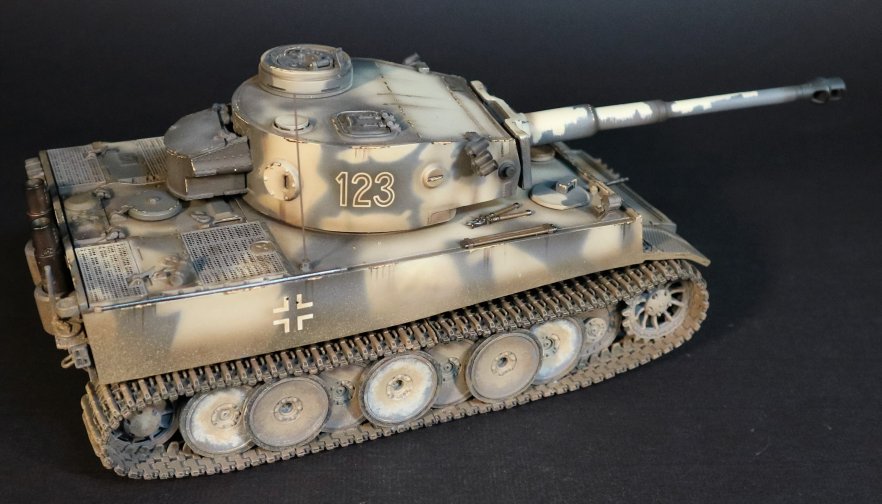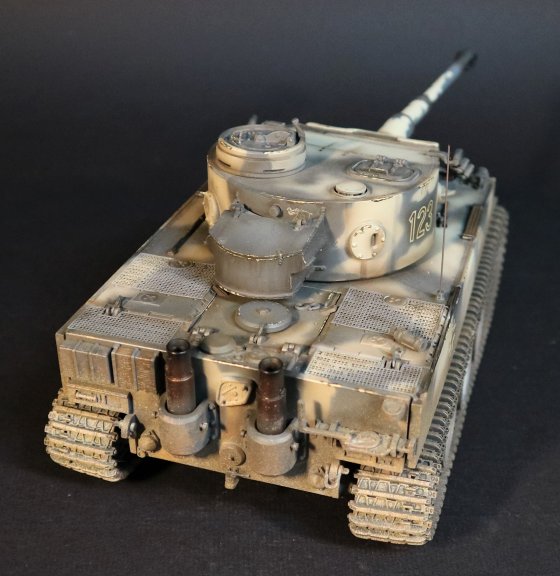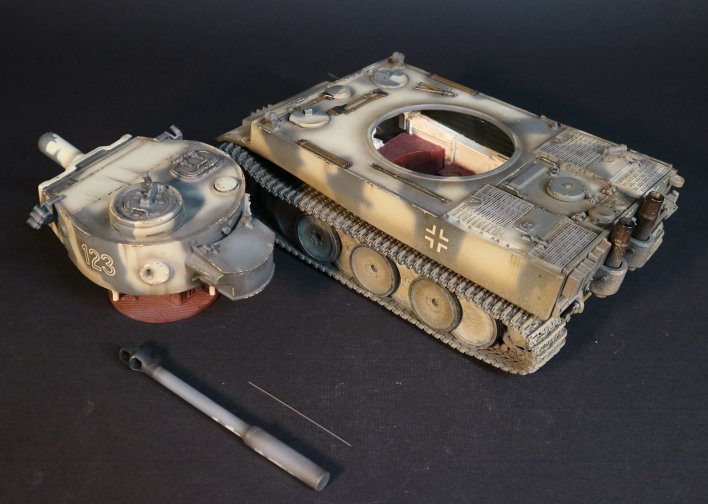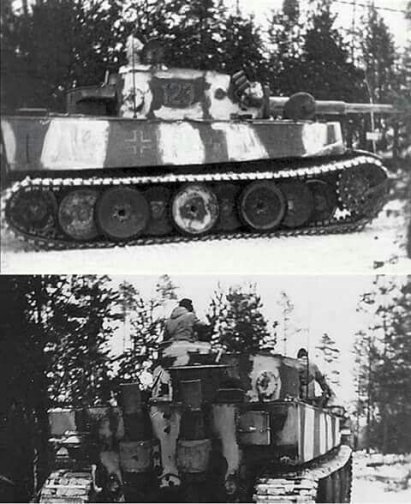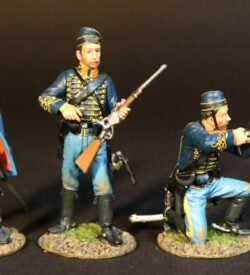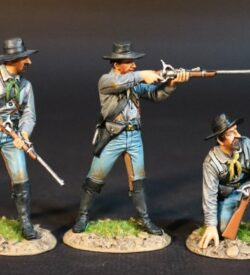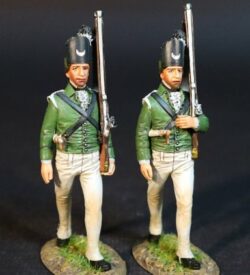German Panzerkampfwagen “Tiger” Ausf. E (Sd.Kfz.181), InitialGA-52 Production, Tiger #123, Schwere Panzerabteilung 502, Second Battle of Lake Ladoga, January 1943
$408.00
Description
Without a doubt the most iconic tank of World War Two, the Tiger earned a deadly reputation and struck fear into the hearts of its Allied opponents in all theatres of war. Its undisputed battlefield superiority, based on its lethal cannon and superior armor protection, gained the Tiger an almost mystical reputation, particularly among its former enemies. Such was the fear of the Tiger that the sighting or mere mention of Tigers on the battlefield could cause enemy troops to panic. JJD announce the release of the latest “big cat” and its first model of the iconic Tiger tank.
Design for the Tiger was carried out in earnest beginning in late 1939 with two competing designs by Dr.ing.h.c.F. Porsche K.G. of Stuttgart and Henschel & Sohn of Kassel (commonly referred to simply as Porsche and Henschel). The Porsche prototype incorporated a Krupp designed turret mounting an 8.8cm KwK / L56 gun while the Henschel design used a Rheinmetall turret mounting a 7.5cm KwK / L70 gun. The Rheinmetall designed Tiger turret was significantly smaller than the Krupp design and looked strikingly similar to the turret used on the later Panther. Of the two hull designs, the Porsche hull was much more technologically advanced. It envisioned use of electric engines and either an electric or hydraulic transmission whereas the Henschel design utilized a standard (yet powerful) gasoline engine and mechanical transmission. Due to a number of factors, including automotive design problems with the Porsche Tiger, Krupp’s ability to maintain a monopoly on tank gun production, and the ease with which the Henschel chassis could be modified to accept the larger Krupp turret designed for its competitor, the final Tiger became a combination of the Porsche and Henschel designs. The 8.8cm / L56 gun Krupp turret (originally designed for the Porsche Tiger) was mated to the Henschel Tiger chassis…and gave us the legendary Tiger appearance. (Interestingly, a single complete Porsche Tiger served as a command tank and saw combat use with the schwere Panzerjager Abteilung 653, who were equipped with the Ferdinand/Elefant tank destroyer that used the Porsche Tiger chassis.)
Thus was born the final design of the Tiger. When introduced, it was the most powerful tank in existence, and its combination of firepower and armor protection outclassed all its Allied opponents. The Tiger’s offensive punch was provided by the 8.8cm KwK 36 / L56 cannon. Derived from the equally iconic FlaK 36 dual purpose anti-aircraft/anti-tank cannon, the KwK 36 was capable of penetrating 100mm of armor at 1,000 meters. Coupled with a flat shooting trajectory and excellent optics, the Tiger’s cannon was capable of first round hits out to 1,000 meters. There are numerous documented instances of the Tiger’s cannon rounds penetrating the front hulls of T-34s and exiting the rear of the tank through the engine bay. Essentially, if a Tiger could hit an enemy tank it usually resulted in its destruction. The Tiger’s firepower was complemented with exceptional armor protection, provided by 100mm of armor for the front of the hull and turret, 80mm for the sides and rear of the hull and turret, and 100-120mm for the gun mantlet. This armor protection was almost invulnerable to the 75mm guns of the Western Allies’ tanks and the 76.2mm guns on the Russian T-34 and KV-1 tanks in the 1942-1943 time period. Only at extremely close ranges did Allied tankers have any hope of penetrating a Tiger’s armor, and stories abound of Allied tankers watching in horror as their armor piercing rounds hit and harmlessly bounced off the Tiger’s thick armor. One Tiger is known to have taken over 250 hits from enemy weapons of all calibres and survived. Together, the Tiger’s excellent firepower and armor protection resulted in a tank that could destroy its enemy out to distances of up to 2,000 meters, but the Tiger’s enemies had to close to within 200 meters to have any hope of defeating a Tiger. Lastly, and contrary to popular belief, the Tiger was not the “lumbering behemoth” it is often portrayed as. While its massive 56 ton weight could lead to the Tiger breaking through bridges or becoming bogged down in wet and muddy terrain, when employed on suitable ground the Tiger possessed good cross country mobility and was actually quite maneuverable. It had a tighter turning circle than the Sherman and also possessed the ability to counter-rotate its tracks, whereby it could have one track moving forward while the other track was moving in reverse. This procedure allowed the Tiger to essentially turn in place to quickly bring its cannon to bear or to face its thicker frontal armor towards the enemy.
While the Tiger’s reputation became legendary, it had a less than glamorous combat debut. The first Tigers were issued to schwere Panzerabteilung 502 (s.Pz.Abt. 502) under the first organizational tables for a Tiger abteilung, where each platoon of four tanks consisted of two Tigers and two Panzer IIIs (both Panzer III Ausf. L and Ausf N were employed by s.Pz.Abt. 502). The Abteilung was assigned to Heeresgruppe Nord (Army Group North), who sent them to the Leningrad front in late August of 1942. This area of operations was characterized by forests with numerous streams and wet, swampy areas…terrain wholly unsuited for the Tigers! Consequently, the Tiger’s combat debut on 22 September 1942 while attached to the 170. Infanterie Division was disastrous, with one of the four Tigers employed getting hit and breaking down due to engine failure while the other three Tigers got bogged down in the swampy terrain. While three of the four Tigers were recovered, the fourth Tiger remained bogged down until 25 November 1942, when it was finally blown up by German forces. Subsequent combat with the 170. Infanterie Division was limited in effectiveness, with the Tigers being limited to forest roads and tracks that could support their weight.
Following these initial combat operations, the s.Pz.Abt 502 saw a period of relative quiet in November and December, where maintenance and refitting was conducted and the Tigers and Panzer IIIs received winter camouflage consisting of large bands of whitewash painted over their Dunkelgrau basecoats. Additionally, the Tigers were fitted with sheet metal smokestacks over their engine exhausts, to hide the exhaust flames, which could be seen from a good distance. Then in January of 1943, the Russians launched Operation Iskra (Spark); named the Second Battle of Lake Ladoga by the Germans. The intent of Operation Spark was to create a land connection and partially lift the siege of Leningrad. During the Second Battle of Lake Ladoga, s.Pz.Abt 502 combat effectiveness rose while conducting defensive operations supporting various infantry divisions. One notable action near Goro-Dok on 13 January was a counterattack by four Tigers and eight Panzer IIIs in support of Grenadier Regiment 283 of the 96. Infanterie Division that destroyed twelve T-34s with the loss of zero German tanks. In total, the s.Pz.Abt 502 destroyed 55 enemy tanks during the battle.
Following the Second Battle of Lake Ladoga, the Russians launched Operation Polar Star, whose aim was to completely lift the Siege of Leningrad. From February to March of 1942, s.Pz.Abt 502’s effectiveness increased as it supported numerous infantry divisions in defensive operations. Notable actions occurred on 11 February, when three Tigers and three Panzer IIIs supported the SS-Polizei Division at Mischkino and knocked out 32 Russian tanks. Another notable action occurred on 17 February, when the Abteilung’s Tigers knocked out 10 Russian KV-1 heavy tanks in the matter of a few minutes. Operation Spark failed, and while a land connection remained intact, Leningrad remained under siege until 27 January 1944. Following these introductory battles, s.Pz.Abt 502 would subsequently be upgraded to a full Tiger Abteilung complete with three companies of Tiger tanks. s.Pz.Abt 502 would continue to fight on the Eastern Front until the end of the war, where its kill continued to climb. In total, s.Pz.Abt. destroyed 1,400 Soviet tanks for the loss of 105 Tiger Is and 8 Tiger IIs. The Abteilung’s Tiger Aces included Oberleutnant Otto Carius (150 kills), Hauptmann Bölter (144 kills) and Feldwebel Kerscher (100 kills).
The JJ Designs Tiger represents Tiger #123 of s.Pz.Abt. 502, as it appeared during the Second Battle of Lake Ladoga in January 1943. One of the initial Tigers produced, it carries the distinctive features of these early tanks along with those of s.Pz.Abt. 502:
– early turret with two rear pistol ports and no escape hatch
– early style smooth gun mantlet
– early style thin front mudguards
– a Panzer III Rommelkiste (turret stowage bin) fitted to the rear of the turret
– no side mudguards, because Tiger #123 was produced without mounts for them
– elongated sheet metal smokestacks fitted to the engine exhaust (a field modification unique to s.Pz.Abt. 502)
– the forward outer road wheels removed; this modification was employed by multiple Tiger units on the East Front to aid in minimizing the buildup of dirt and mud in the tracks – Dunkelgrau base paint color with wide bands of winter whitewash
– s.Pz.Abt. 502’s “Mammut” (Mammoth) unit insignia painted on the right front glacis plate and above the rear turret stowage bin
– white outline numbers and Balkenkreuz
The JJD Tiger also comes with the following features:
– all turret hatches open
– detailed turret and hull interior
– opening engine hatch with detailed engine

